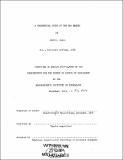A theoretical study of the sea breeze
Author(s)
Walsh, John E. (John Edward), 1948-
DownloadFull printable version (4.271Mb)
Other Contributors
Massachusetts Institute of Technology. Dept. of Meteorology.
Advisor
Norman A. Phillips.
Terms of use
Metadata
Show full item recordAbstract
The linearized Boussinesq equations with rotation, viscosity, conduction, and a mean stratification are used to model the sea breeze in two dimensions. the motion is forced by a prescribed surface temperature function. The linear model produces a sea breeze with realistic velocities and spatial dimensions. Hydrostatic solutions are found to differ very little from the nonhydrostatic solutions. The phase of the solution depends on the Coriolis parameter f; the only distinguishable feature of the solution at the inertial latitude is a slight amplitude maximum far from the coastline. Both the phase and the amplitude depend on the stability parameter N². An inversion, simulated by a discontinuity in N², reduces the intensity of the circulation. The land-sea temperature difference required by the model to create a net onshore flow in opposition to a basic current agrees well with the empirical criterion defined by Lyons (1972). The computed vertical heat fluxes, when summed along the coastlines of the principal land masses, indicate that the sea breeze effect can account for several per cent of the globally averaged vertical flux of sensible heat at a height of several hundred meters. The nonlinear advection process is studied with a finite difference model based on a series of overlapping grids. The principal effect of the nonlinear terms is a landward advection of the sea breeze circulation.
Description
Thesis (Ph. D.)--Massachusetts Institute of Technology, Dept. of Meteorology, February 1974. "December, 1973." Vita. Includes bibliographical references (leaves 125-128).
Date issued
1974Department
Massachusetts Institute of Technology. Department of Meteorology; Massachusetts Institute of Technology. Department of Earth, Atmospheric, and Planetary SciencesPublisher
Massachusetts Institute of Technology
Keywords
Meteorology.